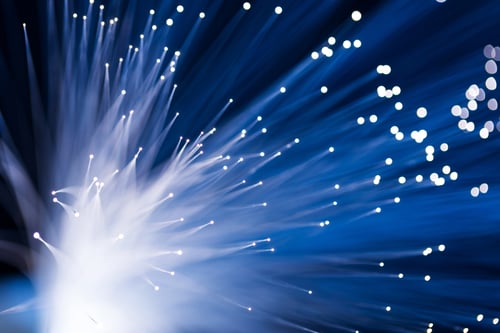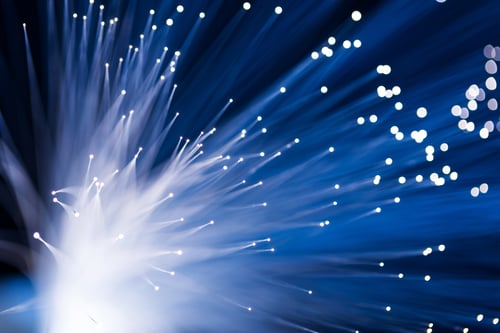
It’s been 30 years since fiber optic cables ushered in a new networking era that fueled the rise of the internet and our modern digital world.
Fiber optic cables, with their ability to transmit more data at a higher speed, became the backbone of the internet, and during the COVID-19 pandemic became a lifeline with work, school and social life shifting online. Fiber optic connections were no longer a luxury but a necessity.
“This is an essential item at this point. The pandemic has taught us that the internet is the backbone of business, and it’s the backbone of education, and it’s the backbone of the community. And as a result, that fiber optic connection or high-speed internet connection shouldn’t be seen as a luxury item,” Ted Rockwell past chair of the board of directors for the Boulder Chamber told the Daily Camera.
Understanding How Fiber Optic Cables Work
It helps to have a basic understanding of how fiber optic cables work to transmit information. While legacy copper cables used electric pulses to transmit data, fiber optic cables use light pulses.
Fiber optical cables are constructed of glass strands, each as small as a human hair, with an outer layer of cladding all wrapped inside an insulated jacket. In simplest terms, the “one bits” and “zero bits” of digital transmission are sent via a laser that generates light inside the cable.
The light signals travel through a glass tube in the optical core in the center of the fiber optic cables. This fiber optic light signal can travel as far as 60 miles before needing regeneration. The optical core size plays an important factor in the distance and quality of signal as the smaller the core, the farther the light pulse can travel on its own.
Three Types of Fiber Optical Cables
There are three main types of fiber optical cables:
- Single Mode
- Multimode
- Plastic Optical Fiber (POF)
“You will most likely come across the single mode and multimode type, instead of the plastic fiber type because of application and popularity,” writes Greg Martinez in Long Range Signal.
The difference between single mode and multimode fiber optic cables are all in the name:
- Single mode fiber optic cables allow for a single light path and have a small core, anywhere between 8.3 and 10 microns.
- Multimode fiber optic cables allow for multiple light paths and have a larger core, anywhere from 50 to 100 microns.
POF does not use glass to transmit signals but is made of a polymer with a core 10 times larger than multimode fiber optic at 1 millimeter.
Here is a closer look at each of the three types of fiber optic cables.
Single Mode Fiber Optical Cables
Single mode fiber optical cable is the choice for carrying high data rates and/or long-distance hauls. A single path, also called mode, is used to carry light through small cores, typically 8-9 microns. Since there is just one light wave in a tight space, there is less signal attenuation, or reduction in strength, and less external interference.
Single mode, typically with a yellow jacket color but can come in a variety of colors, comes in two main categories:
- OS1: Single mode fiber optic cable that is tight buffered and designed for indoor applications. OS1 is used in settings such as data centers, office parks, campuses, factories, moderate telco loops, LANs and point-to-point links in cities. OS1 can transport data at speeds up to 10G for distances up to six miles.
- OS2: Single mode fiber optic cable in a loose tube cable and designed for outdoor settings. OS2 can carry speeds up to 100G for distances up to 124 miles. OS2 is used for applications such as long-distance telco backbone and backhaul and direct bury along streets and railroads.
Multimode Fiber Optical Cables
Multimode fiber optical cables, with its multiple light paths, allows for higher bandwidth over short to medium distances.
While the increased number of light reflections increases multimode fiber optic cables ability to transmit more data, it also can lead to a higher rate of attenuation and dispersion, which leads to a loss of signal quality over long distances.
Multimode fiber optic cables, ideal for data centers, can be identified by their optical mode (OM) designation governed by ISO/IEC 11801 standard.
The five categories of multimode fiber optic cables are:
- OM1: Multimode fiber optic cables typically have an orange jacket color and 62.5-micron core. OM1 can transmit at a data rate of 10G up to 100 feet. OM1 usually uses LED light sources and can be used for 100 Megabit Ethernet applications as well as LANs, private networks, and short-haul networks.
- OM2: Multimode fiber optic cables typically have an orange jacket color and 50-micron core. OM2 can transmit at a data rate of 10G up to 260 feet. OM2 also uses LED light sources like OM1. Typically used for 10G Ethernet applications as well as LANs, private networks, and short-haul networks.
- OM3: Multimode fiber optic cables typically have an aqua jacket color and 50-micron core. OM3 can transmit at a data rate of 10G up to 1,000 feet. OM3 can support 40G to 100G up to 330 feet. OM3 has increased speeds because it uses fewer modes of light. Larger private networks can take advantage of OM3.
- OM4: Multimode fiber optic cables typically have an aqua jacket color and 50-micron core. OM4 is designed for use with vertical-cavity surface-emitting laser (VSCE transmission and has a data rate of 10G up to 1,300 feet. OM3 can support 40 to 100G up to 500 feet. High-speed networks, financial centers, corporate campuses, and data centers all make use of OM4.
- OM5: Multimode fiber optic cable typically have a lime green jacket color and 50-micron. OM5 is the newest multimode fiber optic cable and fully compatible and can mate with OM3 and OM4 cabling. OM5 was designed to support short wavelength division multiplexing (SWDM) and can transmit at the same speed and distances as OM4. Data centers and high-speed applications are the main use for OM5.
Multimode fiber optic cables may be manufactured with either graded or step-indexed profiles:
- Step-Index Multimode Fiber: This cable has a thick core for signal transmission. The light signals enter at various angles and transmit at different rates with some signals moving directly and others zigzagging or bouncing off the cladding as they travel. Step-index is best for shorter distances.
- Graded-Index Multimode Fiber: This cable has a core arranged in circles, often described in terms of the rings of a tree. Long signals can travel faster in graded-index fiber as it can handle multiple wavelengths at the same time. LANs are a typical application for graded-index multimode fiber.
Plastic Optical Fiber (POF)
POF does not offer the same type of reach as single mode and multimode with data rate transmission at 150 Mbps over 164 feet.
This cable can be more durable than glass as it is quite resistant to bending and stretching. Can be used for short distances often in the automotive, aircraft and industrial industries.
DCS Offers Highest Quality Fiber Optic Assemblies
At DCS the highest-quality fiber assemblies are Made in America in a facility in Dallas including:
- Fiber Optic Trunk Cables: Ready for fast deployment and ease of migration to 40G and 100G applications.
- Fiber Optic Jumper Cables: Provide the “final feet” of connectivity between patch panels and the central patching location or between patch panels and production hardware at the zone patching location.
- Fiber Optic Harnesses: Used as a quick connect extension when coupled with an MTP trunk cable.
Contact DCS today to find out how we can manufacture and install the right connectivity solution for your data center.
Subscribe to News
Recent posts
LATEST NEWS
Monday August 7, 2023







